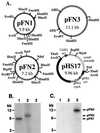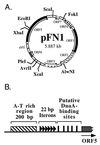Native plasmids of Fusobacterium nucleatum: characterization and use in development of genetic systems
- PMID: 10648549
- PMCID: PMC94399
- DOI: 10.1128/JB.182.4.1176-1180.2000
Native plasmids of Fusobacterium nucleatum: characterization and use in development of genetic systems
Abstract
Three native plasmids of Fusobacterium nucleatum were characterized, including DNA sequence analysis of one plasmid, pFN1. A shuttle plasmid, pHS17, capable of transforming Escherichia coli and F. nucleatum ATCC 10953 was constructed with pFN1. pHS17 was stably maintained in the F. nucleatum transformants, and differences in the transformation efficiencies suggested the presence of a restriction-modification system in F. nucleatum.
Figures



References
-
- Altschul S F, Gish W, Miller W, Myers E W, Lipman D J. Basic local alignment search tool. J Mol Biol. 1990;215:403–410. - PubMed
-
- Benachour A, Frere J, Novel G. pUCL287 plasmid from Tetragenococcus halophila (Pediococcus halophilus) ATCC 33315 represents a new theta-type replicon family of lactic acid bacteria. FEMS Microbiol Lett. 1995;128:167–176. - PubMed
Publication types
MeSH terms
Substances
Associated data
- Actions
- Actions
Grants and funding
LinkOut - more resources
Full Text Sources
Molecular Biology Databases
Miscellaneous

